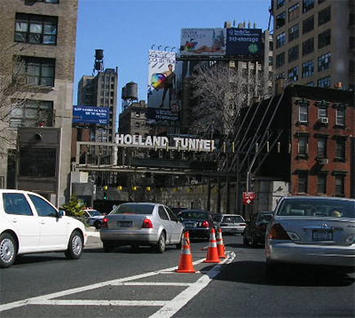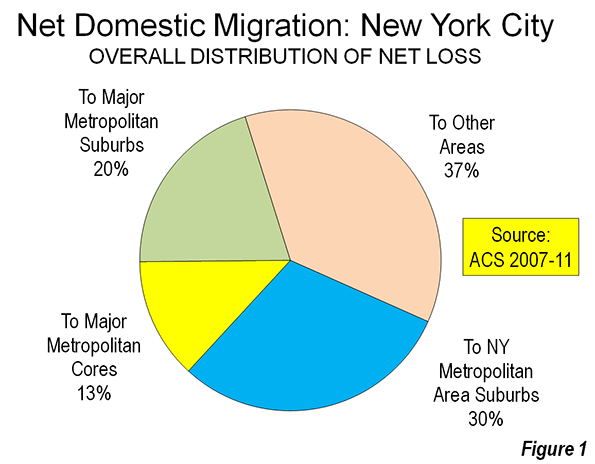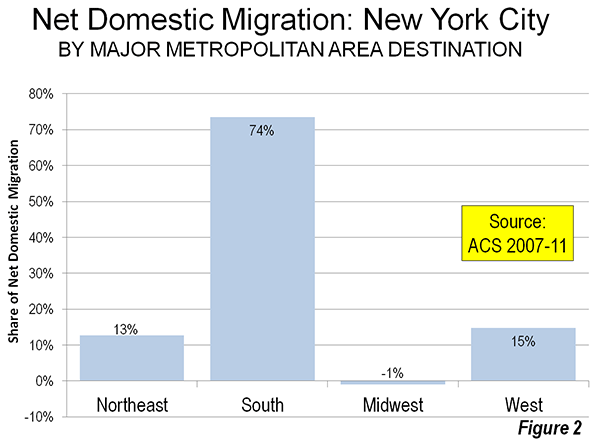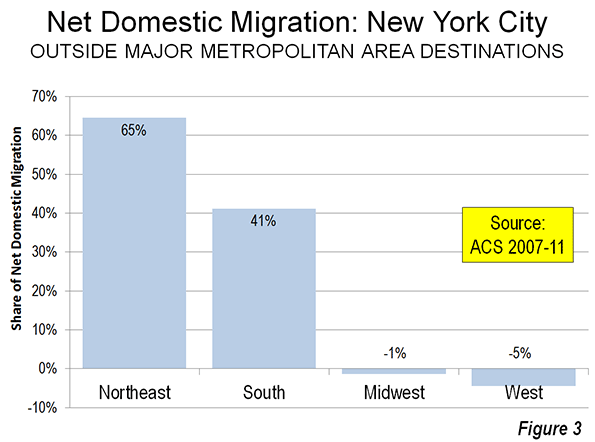
The American Community Survey has released domestic migration data that was collected over a five year period (2007 to 2011). There is newer domestic migration data available, such as is annually provided by the Census Bureau's population estimates program, but not in the detail that the latest data provides.
The new release is significant because domestic migration data is provided between each of the nation's more than 3,100 counties. Because the survey was taken over a five-year period, the data represents, in effect, a one-fifth snapshot of domestic migration for each of the years from 2007 to 2011. Each year respondents are asked where they lived a year ago. It is thus a rolling annual figure, rather than a picture of a single year.
The Uniqueness of New York City
The city of New York provides an interesting case for many reasons. The city is by far the largest municipality in the United States and the only municipality composed of at least two complete counties. New York is coterminous with five counties. New York also has by far the greatest extent of high density in the United States, comprising more than 85 percent population of zip codes with greater than 25,000 per square mile density (10,000 per square kilometer).
Finally, New York is at the center of the largest metropolitan area in the United States, which in its expanded, combined form (combined statistical area) has a population of 23.1 million, most of which (20.7 million) is in a built-up urban area that covers the largest land area in the world (has the largest urban footprint). This is more than a third larger than Tokyo, the world's largest urban area by population, with an 80 percent higher population. It is surprising to many that New York's urban area covers nearly twice the land area of Los Angeles and is nearly one-quarter less dense.
Domestic Migration and New York City
New York's broad suburban expanse generally resembles the suburbs of Dallas-Fort Worth, Seattle or Toronto and much of its Staten Island borough (county of Richmond) looks more like suburban New Jersey than New York, most of its urban core – the city of New York – is unique.
And the city continues to export large numbers of people – 90,000 more than arrived in the rolling year represented by the latest ACS data. This is a big number, representing 1.1 percent of the city's 2010 population. This is a larger loss than Philadelphia (0.5 percent), but smaller than Washington (1.4 percent).
This has been evident in the large numbers net domestic migrants reported each year in the Census Bureau estimates. The data shows that people are leaving not only the city of New York not only for the suburbs, but moving in even greater numbers to beyond the metropolitan area. Approximately 27,000 more New Yorkers moved to the suburbs than to the city of New York over the period. However, an even larger 63,000 net domestic migrants left the city of New York for areas outside the metropolitan area.
Approximately 30,000 of these inter-regional migrants moved to other major metropolitan areas (those with more than 1 million population). By far the largest share – 74 percent – of the city's net domestic migrants to other major metropolitan areas moved to the South. Four of the five largest major metropolitan gainers at the city's expense were Miami (net 5,600) and Atlanta (net 4,300), followed by Tampa-St. Petersburg, and Dallas-Fort Worth.
Another 13 percent of the city's net domestic migrants moved to other major metropolitan areas in the Northeast. Rochester was the largest gainer with nearly 1000 net domestic migrants from the city of New York, followed by Philadelphia. The city gained more than 250 residents from Boston.
Approximately 9 percent of the city’s net domestic migrants moved to major metropolitan areas in the West. Los Angeles led in the West, gaining 1,800 net migrants from the city. The outlier was the Midwest, which sent more than 300 net migrants to the city (Figure 1).
City residents tended to move to the suburbs of the major metropolitan areas, which attracted 60 percent, while the core cities received 40 percent of the net migrants.

Dispersing Beyond the Larger Metropolitan Areas
However, the most striking trend is that most of the net domestic migrants who left the city of New York to move outside the New York metropolitan area moved to areas outside the major metropolitan areas. In this regard, New Yorkers who move seem to be more inclined toward the greater dispersion of the nation's smaller metropolitan areas and micropolitan areas.
Over the period, approximately 32,500 net domestic migrants left the city for areas outside major metropolitan areas. This is more than moved to the other major metropolitan areas or to the New York metropolitan area suburbs (Figure 2).

The most surprising finding is that the majority (65 percent) of net domestic migrants from the city who moved to outside the major metropolitan areas settled in the Northeast. Most of these 23,000 residents moved to smaller areas in Upstate New York and Pennsylvania. Virtually all of the other migrants not moving to major metropolitan areas moved to states in the South (41 percent). In contrast, there was a small amount of migration to New York from the West and Midwest totaling less than 2,000 (Figure 3).

Outside New York and New Jersey, which contain nearly all of the New York metropolitan area, Florida received the largest number of net migrants from the city (11,000), followed by Pennsylvania (8,000). Only 100 of the Pennsylvania migrants were to Pike County, which is in the New York metropolitan area. Georgia, Texas and North Carolina all received approximately 5,000 net migrants from the city. The top ten destinations were rounded out by Virginia, Connecticut and South Carolina. A total of 37 states received net domestic migrants from the city. Only Alaska and the District of Columbia sent more than 1,000 net domestic migrants to New York City.
Conclusion
The New York City migration data indicates continuing dispersion of the population. People are moving from the core to the periphery in New York, and many going beyond to less urban areas in the Northeast. More are moving to other major metropolitan and other smaller areas, located for the most part in the South. This year's brutal winter could make the South look even better to New Yorkers.
Wendell Cox is a Visiting Professor, Conservatoire National des Arts et Metiers, Paris and the author of “War on the Dream: How Anti-Sprawl Policy Threatens the Quality of Life.
Photo: Leaving New York City via the Holland Tunnel (by author)













NY housing too expensive, and not enough middle class jobs
I was living in NYC, having a great time, until the Recession hit and my job situation changed. My employer left to Upstate NY because the rents were too expensive, even for a global corporation like mine, and I left right after when I couldn't find what I wanted. No matter how walkable and wonderful it is, if you don't have a job, or can't find middle-class housing, it's impossible.
For the middle-class, jobs and schools come first, and space for kids. That's why I believe the best change cities can make in urban development is retrofitting their suburbs and surrounding neighborhoods to be more mixed use and walkable, and stop spending so much money bringing big expensive projects to the urban core. The city centers are too small and overbuilt to fit all people, and not everybody wants to live in a high rise condo.
no surprise
I would say the leading reason people are leaving NYC is cost of living, plain and simple. And the fact that it's a pretty inhospitable place for small children. I know because I'm one of them. I am a 30-something with a toddler, and we are trying to leave NYC. Great place when you're just out of college and single, terrible place when you're 35 with a family. And so the cycle continues.
New York is special
I think Mr. Cox is right about the weather, but that has to be a small factor. The major factor driving net migration out of the city is the over-regulation of small businesses. Taxicabs is a particularly egregious example--the city is much more concerned about preserving the value of the medallions than it is in providing good service to residents. Or creating new jobs.
Still, NYC is special. I've posted my own thoughts here: http://trotskyschildren.blogspot.com/2013/12/why-new-york-is-different.h.... It will be a long time before politicians succeed in destroying the City of New York (though they are trying hard).